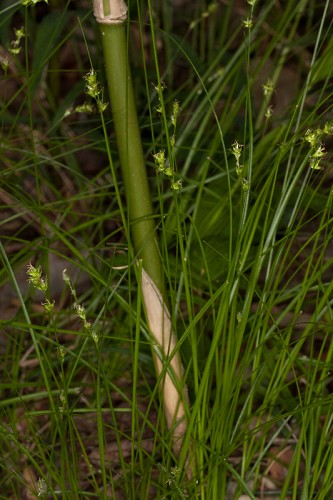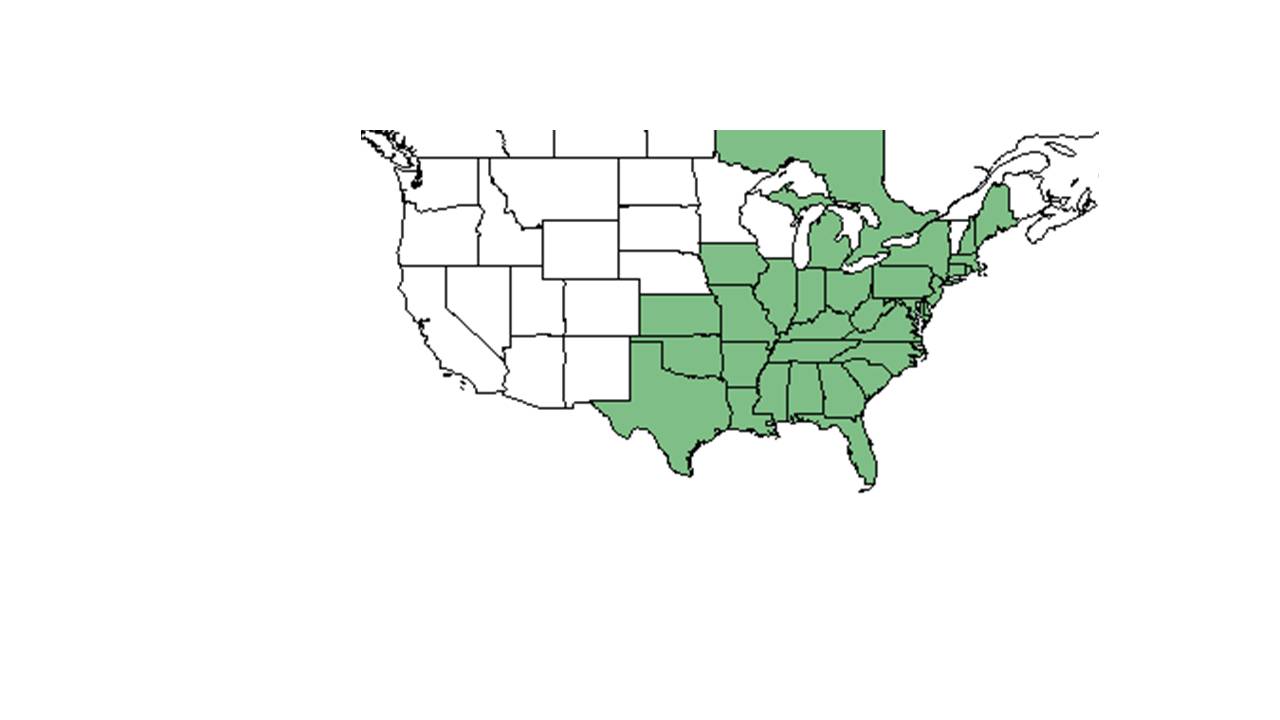Difference between revisions of "Carex retroflexa"
(→Ecology) |
(→Taxonomic notes) |
||
| (One intermediate revision by one other user not shown) | |||
| Line 20: | Line 20: | ||
Common name: Reflexed sedge | Common name: Reflexed sedge | ||
==Taxonomic notes== | ==Taxonomic notes== | ||
| − | Synonyms: | + | Synonyms: ''Carex retroflexa'' var. ''retroflexa''<ref name=weakley>Weakley, A.S. 2020. Flora of the Southeastern United States. Edition of 20 October 2020. University of North Carolina at Chapel Hill, Chapel Hill, North Carolina.</ref> |
| − | Varieties: none | + | Varieties: none<ref name=weakley/> |
==Description== | ==Description== | ||
| Line 37: | Line 37: | ||
Associated species include ''Carex albolutescens, Carex atlantica, Carex complanata, Carex lurida, Carex venusta, Carex capillacea'' and sphagnum species.<ref name="fsu"/> | Associated species include ''Carex albolutescens, Carex atlantica, Carex complanata, Carex lurida, Carex venusta, Carex capillacea'' and sphagnum species.<ref name="fsu"/> | ||
| − | ===Phenology===<!--Timing off flowering, fruiting | + | ===Phenology===<!--Timing off flowering, fruiting, and environmental triggers. Cite PanFlora website if appropriate: http://www.gilnelson.com/PanFlora/ --> |
''C. retroflexa'' has been observed flowering in April and May and fruiting from March to May.<ref name="fsu"/><ref>Nelson, G. [http://www.gilnelson.com/ PanFlora]: Plant data for the eastern United States with emphasis on the Southeastern Coastal Plains, Florida, and the Florida Panhandle. www.gilnelson.com/PanFlora/ Accessed: 7 DEC 2016</ref> | ''C. retroflexa'' has been observed flowering in April and May and fruiting from March to May.<ref name="fsu"/><ref>Nelson, G. [http://www.gilnelson.com/ PanFlora]: Plant data for the eastern United States with emphasis on the Southeastern Coastal Plains, Florida, and the Florida Panhandle. www.gilnelson.com/PanFlora/ Accessed: 7 DEC 2016</ref> | ||
<!--===Seed dispersal===--> | <!--===Seed dispersal===--> | ||
| Line 44: | Line 44: | ||
===Fire ecology===<!--Fire tolerance, fire dependence, adaptive fire responses--> | ===Fire ecology===<!--Fire tolerance, fire dependence, adaptive fire responses--> | ||
Populations of ''Carex'' species have been known to persist through repeated annual burns.<ref>Robertson, K.M. Unpublished data collected from Pebble Hill Fire Plots, Pebble Hill Plantation, Thomasville, Georgia.</ref> | Populations of ''Carex'' species have been known to persist through repeated annual burns.<ref>Robertson, K.M. Unpublished data collected from Pebble Hill Fire Plots, Pebble Hill Plantation, Thomasville, Georgia.</ref> | ||
| − | <!--===Pollination and | + | |
| + | <!--===Pollination===--> | ||
| + | <!--===Herbivory and toxicology===--> | ||
===Diseases and parasites=== | ===Diseases and parasites=== | ||
Latest revision as of 18:11, 22 May 2023
| Carex retroflexa | |
|---|---|

| |
| Photo by John R. Gwaltney, Southeastern Flora.com | |
| Scientific classification | |
| Kingdom: | Plantae |
| Division: | Magnoliophyta - Flowering plants |
| Class: | Liliopsida – Monocotyledons |
| Order: | Poales |
| Family: | Cyperaceae |
| Genus: | Carex |
| Species: | C. retroflexa |
| Binomial name | |
| Carex retroflexa Muhl. ex Willd. | |

| |
| Natural range of Carex retroflexa from USDA NRCS Plants Database. | |
Common name: Reflexed sedge
Contents
Taxonomic notes
Synonyms: Carex retroflexa var. retroflexa[1]
Varieties: none[1]
Description
A description of Carex retroflexa is provided in The Flora of North America. This species is similar to C. texensis, but can be told apart by having an perigynium wider than 1.3 mm and a spongy layer more than 1.1 mm.[2]
Distribution
Ranges from Texas to Kansas to Iowa, east to Indiana and Michigan, north to Quebec and Maine and south to the gulf coast states.[2]
Ecology
Habitat
This species has been found along rivers in rich deciduous woods and in floodplains surrounded by wet sphagnum moss. It has also been observed growing alongside trails at the edge of woodlands. It does well in partial to deep shade environments in drying sandy loam of floodplains.[3]
Associated species include Carex albolutescens, Carex atlantica, Carex complanata, Carex lurida, Carex venusta, Carex capillacea and sphagnum species.[3]
Phenology
C. retroflexa has been observed flowering in April and May and fruiting from March to May.[3][4]
Fire ecology
Populations of Carex species have been known to persist through repeated annual burns.[5]
Diseases and parasites
The introduced earthworm Lumbricus terrestris significantly decreases the growth of C. retroflexa by decreasing the number of culms.[6]
Conservation, cultivation, and restoration
Cultural use
Photo Gallery
References and notes
- ↑ 1.0 1.1 Weakley, A.S. 2020. Flora of the Southeastern United States. Edition of 20 October 2020. University of North Carolina at Chapel Hill, Chapel Hill, North Carolina.
- ↑ 2.0 2.1 Robert, G. D. and E. H. Philip (2003). "Recommendations concerning the Identification of Carex retroflexa and Carex texensis (Cyperaceae; Section Phaestoglochin Dumort)." Castanea 68(3): 245-253.
- ↑ 3.0 3.1 3.2 Florida State University Robert K. Godfrey Herbarium database. URL: http://herbarium.bio.fsu.edu. Last accessed: June 2014. Collectors: L. C. Anderson, L. W. Curtis, and R. K. Godfrey. States and Counties: Alabama: Wilcox. Florida: Gadsden and Hernando.
- ↑ Nelson, G. PanFlora: Plant data for the eastern United States with emphasis on the Southeastern Coastal Plains, Florida, and the Florida Panhandle. www.gilnelson.com/PanFlora/ Accessed: 7 DEC 2016
- ↑ Robertson, K.M. Unpublished data collected from Pebble Hill Fire Plots, Pebble Hill Plantation, Thomasville, Georgia.
- ↑ [[1]]. Accessed: April 12, 2016